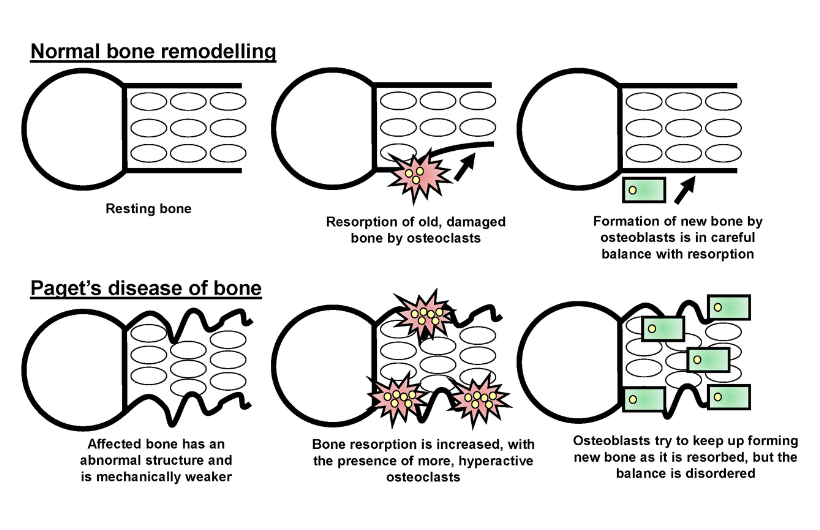What is Paget's disease?
Throughout life, normal bone is renewed and repaired through a process called bone remodelling. Paget’s disease is characterised by abnormalities in this process. The affected bone is renewed and repaired at an increased rate, causing abnormalities in the bone’s structure. Pagetic bone can appear enlarged and misshapen.
The normal bone remodelling process
To understand Paget’s disease, it is necessary first to appreciate how normal bone behaves. Bone is living tissue, which is renewed and replaced throughout life. This process is known as bone remodelling and is important in maintaining a healthy skeleton by ensuring that old or damaged bone is removed from the skeleton and replaced with new healthy bone tissue. This balance of the breakdown of bone (resorption) and the production of new bone (formation) is carefully regulated. There are three main types of bone cell involved in the remodelling process, osteoclasts, osteoblasts and osteocytes. The osteoclasts break down (resorb) old or damaged bone. The osteoblasts then lay down new bone. Some osteoblasts become buried in the newly formed bone and become osteocytes. Osteocytes play a key role in regulating the activity of osteoclasts and osteoblasts. Under normal circumstances, the amount of bone resorbed is exactly balanced by the amount of new bone that is formed. Over time, this bone is mineralised, forming a rigid and strong skeleton.
How does Paget’s disease affect the bone remodelling process?
In Paget’s disease, the processes of bone resorption and bone formation are markedly increased. The osteoclasts are larger than normal and break down bone faster than normal. The osteoblasts respond to this by depositing new bone at an increased rate. This dysregulation of bone turnover in Paget’s disease results in abnormalities of the bone structure, weakening of the bone and enlargement or deformity of the affected bones. Pagetic bone often appears misshapen and enlarged.

Which bones can be affected?
- Paget’s disease may affect only one bone when it is known as monostotic Paget’s disease. If more than one bone is affected, it is known as polyostotic Paget’s disease.
- Whilst any bone can be affected by Paget’s disease, common sites are the pelvis, spine, thigh bone (femur), shin (tibia) and skull.
- It is unclear why only certain bones are affected. It is possible that it may be related to mechanical stresses, which are placed on the skeleton at specific sites or differences in the blood supply to these bones.
Paget's Nurse Helpline
Contact the Paget's Nurse Helpline for information and support on all aspects of Paget’s disease
